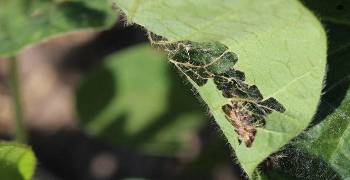By Adam Varenhorst
Insects to Watch For
While scouting soybean this week I noticed quite a few defoliating insects that were present in the field. So far, the feeding injury is minimal, but it is a reminder that we need to be diligent in monitoring leaves for defoliation and fields for these insect pests.
The insects that I was noticing the most were grasshopper nymphs (Figure 1), early instar green cloverworm caterpillars (Figure 2) and thistle caterpillars (Figure 3 and Figure 4).

Figure 1. Grasshopper nymphs feeding on soybean leaves.

Figure 2. Green cloverworm caterpillar. Notice the three abdominal prolegs.

Figure 3. Rolled soybean leaves that are defoliated.

Figure 4. Thistle caterpillar on soybean.
Scouting Strategy
The easiest way to scout for these pests is to monitor fields for defilation as there are multiple pests present. For soybean, the threshold for defoliation is an average of 30% defoliation prior to flowering and an average of 20% defoliation after flowering has begun. In South Dakota, there are some soybean that have begun to flower and these fields should be monitored closely for defoliating insect pests. If defoliation threshold are reached please refer to the 2019 South Dakota Pest Management Guide: Soybeans for a list of labeled insecticides. Always refer to labels for rates.
Source: sdsu.edu